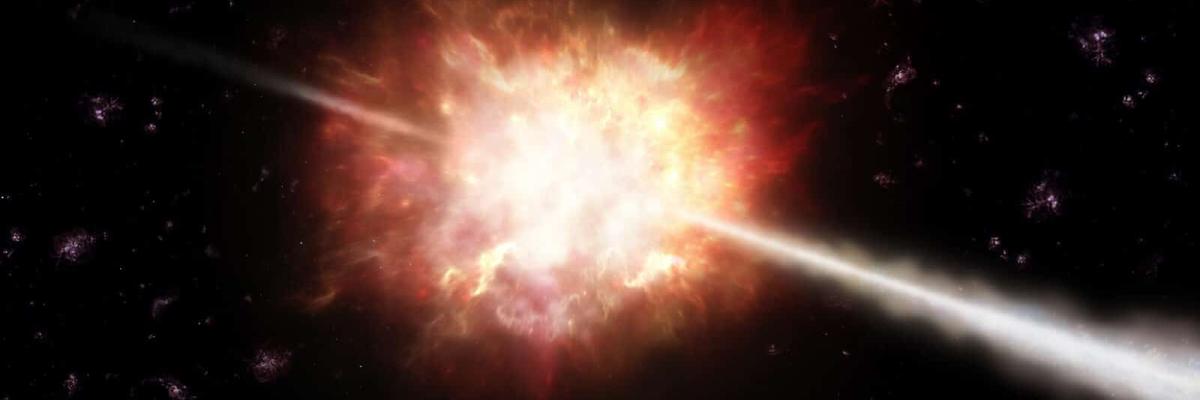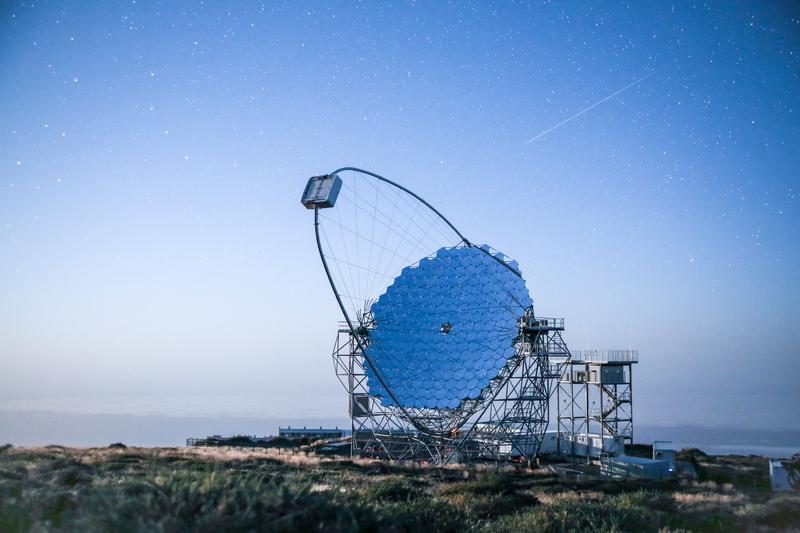Highlight
New Insights into Gamma-Ray Burst Jets from Record-Breaking Cosmic Explosion
July 23, 2025
- Observations of GRB 221009A with the LST-1 telescope offer new clues about the structure of gamma-ray burst jets.
- IFAE researcher Mònica Seglar-Arroyo coordinated the study and co-authored the publication.
- Data were successfully collected under bright moonlight, demonstrating LST-1’s readiness for rapid transient follow-up.

The international CTAO LST Collaboration has released remarkable findings from observations of GRB 221009A—the brightest gamma-ray burst (GRB) ever recorded. Published in The Astrophysical Journal Letters, the study presents in-depth observations made in 2022 using the Large-Sized Telescope prototype, LST-1, during its commissioning phase at the Roque de los Muchachos Observatory on the CTAO-North site in La Palma, Spain. The results offer new insight into the complex nature of GRBs at very high energies and support models involving structured, multi-layered jets.
Mònica Seglar-Arroyo, researcher at the Institut de Física d’Altes Energies (IFAE), is one of the four authors of the publication. She coordinated the project, led the writing of the paper, and participated in key phases of review and analysis. “This observation was a unique opportunity to study the jet structure of GRB,” says Seglar-Arroyo. “The data strongly support the idea of a structured jet, which helps us better understand the central engine driving these explosive events.”

Arnau Aguasca-Cabot, ICCUB-IEEC researcher and coordinator of the study, highlights the implications: “GRB 221009A provides strong evidence for a structured jet in long GRBs,” he explains. “Its detection has significant implications for theoretical models of jets.”. Co-author Pol Bordas, also at ICCUB-IEEC, adds: “Unique events like this GRB, which challenge theoretical models, may reveal insights into the unknown nature of the central engine powering this cosmic jet.”
What are GRBs?
GRBs are among the Universe’s most powerful phenomena, releasing in seconds as much energy as the Sun emits over its entire lifetime. These extragalactic flashes of gamma rays are typically followed by an afterglow lasting from hours to months. Based on their duration, GRBs are classified as long (likely linked to supernovae) or short (thought to result from neutron star mergers). However, despite their brightness, GRBs are difficult to observe in the very high-energy range due to their distance and brief nature.
GRB 221009A: The “Brightest Of All Time”
On 9 October 2022, space-based instruments such as NASA’s Fermi and Swift satellites detected an extraordinarily intense long-duration GRB, named GRB 221009A. The event was so powerful it saturated many detectors and triggered a global observation campaign. LST-1 began observing the event just 1.33 days after the burst, collecting data over a period of 20 days. The data revealed a hint of excess in gamma-ray flux, which, while not sufficient to claim a formal detection, allowed researchers to establish stringent upper limits on the flux and discriminate between competing theoretical models.
The LST-1 observations support theoretical models in which GRBs are powered by structured jets: narrow, ultra-fast cores surrounded by slower, wider sheaths of material. This contrasts with earlier “top-hat” jet models and provides important constraints on the mechanisms driving jet formation in both supernovae and neutron star mergers.
Observations under moonlight
A distinctive challenge of this study was that much of the LST-1 data were taken under very bright moonlight, a condition that normally hampers observations with Cherenkov telescopes. “The fact that LST-1 could operate under such bright conditions is a milestone in itself,” adds Seglar-Arroyo. “It expands our ability to respond swiftly to transient cosmic events, even when the observing conditions are far from ideal.”
The technical solutions implemented by the LST Collaboration allowed LST-1 to be the first Cherenkov telescope to observe the event. This marked the first time the telescope successfully recorded data under bright moonlight—demonstrating its flexibility and opening new avenues for the observation of transient astrophysical phenomena.
- Publication
- IFAE Research group
- Gamma-ray Group
- Contact
